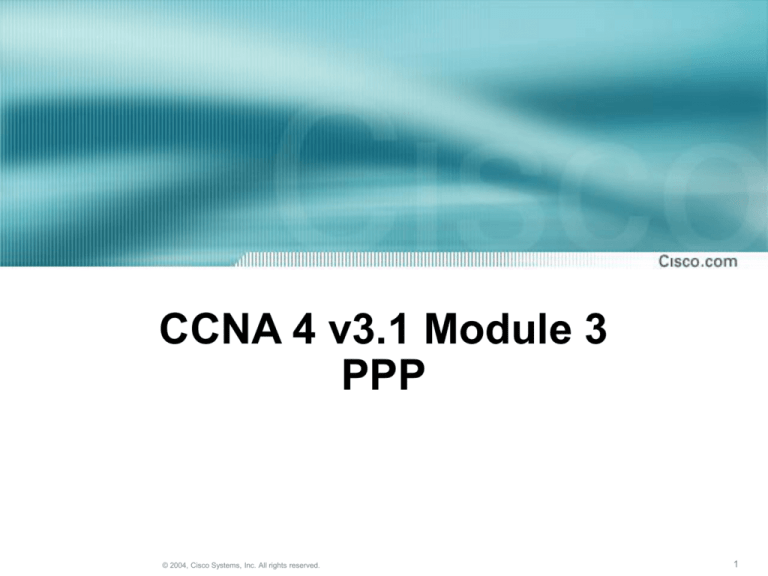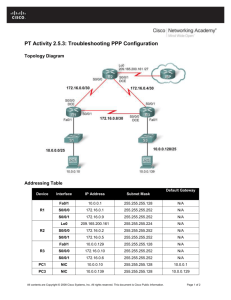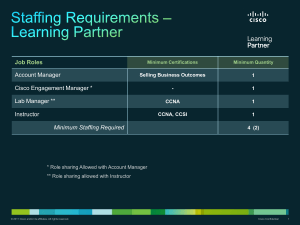
CCNA 4 v3.1 Module 3
PPP
© 2004, Cisco Systems, Inc. All rights reserved.
1
Purpose of This PowerPoint
• This PowerPoint primarily consists of the Target
Indicators (TIs) of this module in CCNA version
3.1.
• It was created to give instructors a PowerPoint to
take and modify as their own.
• This PowerPoint is:
NOT a study guide for the module final assessment.
NOT a study guide for the CCNA certification exam.
• Please report any mistakes you find in this
PowerPoint by using the Academy Connection
Help link.
© 2004, Cisco Systems, Inc. All rights reserved.
2
To Locate Instructional Resource Materials
on Academy Connection:
• Go to the Community FTP Center to locate
materials created by the instructor community
• Go to the Tools section
• Go to the Alpha Preview section
• Go to the Community link under Resources
• See the resources available on the Class home
page for classes you are offering
• Search http://www.cisco.com
• Contact your parent academy!
© 2004, Cisco Systems, Inc. All rights reserved.
3
Objectives
© 2004, Cisco Systems, Inc. All rights reserved.
4
Introduction to Serial Communication
Transmission system encodes bits into electrical
voltage using methods like NRZ-L or AMI
Some of the many serial communications
standards include the following:
RS-232-E
V.35
High-Speed Serial Interface (HSSI)
© 2004, Cisco Systems, Inc. All rights reserved.
5
Time-Division Multiplexing
© 2004, Cisco Systems, Inc. All rights reserved.
6
Demarcation Point
The point in the network where the responsibility
of the service provider or "telco" ends.
© 2004, Cisco Systems, Inc. All rights reserved.
7
DTE-DCE
© 2004, Cisco Systems, Inc. All rights reserved.
8
Serial Connection Options
© 2004, Cisco Systems, Inc. All rights reserved.
9
DTE/DCE Interface
• The DTE/DCE interface for a particular standard
defines the following specifications:
Mechanical/physical - Number of pins and connector
type
Electrical - Defines voltage levels for 0 and 1
Functional - Specifies the functions that are performed
by assigning meanings to each of the signaling lines in
the interface
Procedural - Specifies the sequence of events for
transmitting data
© 2004, Cisco Systems, Inc. All rights reserved.
10
HDLC Encapsulation
© 2004, Cisco Systems, Inc. All rights reserved.
11
Configuring HDLC Encapsulation
© 2004, Cisco Systems, Inc. All rights reserved.
12
Troubleshooting a Serial Interface
© 2004, Cisco Systems, Inc. All rights reserved.
13
Troubleshooting a Serial Interface
• Five possible problem states can be
identified in the interface status line of the
show interface serial display:
Serial x is down, line protocol is down.
Serial x is up, line protocol is down.
Serial x is up, line protocol is up (looped).
Serial x is up, line protocol is down (disabled).
Serial x is administratively down, line protocol is
down.
© 2004, Cisco Systems, Inc. All rights reserved.
14
PPP Layered Architecture
© 2004, Cisco Systems, Inc. All rights reserved.
15
PPP and the Data Link Layer
© 2004, Cisco Systems, Inc. All rights reserved.
16
PPP and the Network Layer
© 2004, Cisco Systems, Inc. All rights reserved.
17
Establishing a PPP Session
© 2004, Cisco Systems, Inc. All rights reserved.
18
PPP Operation
© 2004, Cisco Systems, Inc. All rights reserved.
19
Link Control Protocol Options
© 2004, Cisco Systems, Inc. All rights reserved.
20
PPP Configuration Options
© 2004, Cisco Systems, Inc. All rights reserved.
21
Network Control Protocol
© 2004, Cisco Systems, Inc. All rights reserved.
22
PPP Authentication Protocols
© 2004, Cisco Systems, Inc. All rights reserved.
23
PPP Authentication Protocols
© 2004, Cisco Systems, Inc. All rights reserved.
24
Password Authentication Protocol (PAP)
© 2004, Cisco Systems, Inc. All rights reserved.
25
Challenge Handshake Authentication
Protocol (CHAP)
CHAP provides protection against playback
attack through the use of a variable challenge
value that is unique and unpredictable.
© 2004, Cisco Systems, Inc. All rights reserved.
26
PPP Encapsulation and Authentication
Process
© 2004, Cisco Systems, Inc. All rights reserved.
27
CHAP Authentication Process
© 2004, Cisco Systems, Inc. All rights reserved.
28
Configuring PPP
© 2004, Cisco Systems, Inc. All rights reserved.
29
Configuring PPP Authentication
© 2004, Cisco Systems, Inc. All rights reserved.
30
PAP Configuration
© 2004, Cisco Systems, Inc. All rights reserved.
31
CHAP Configuration
© 2004, Cisco Systems, Inc. All rights reserved.
32
Verifying PPP
© 2004, Cisco Systems, Inc. All rights reserved.
33
PPP Configuration Commands
© 2004, Cisco Systems, Inc. All rights reserved.
34
Debug PPP Authentication
© 2004, Cisco Systems, Inc. All rights reserved.
35
Summary
© 2004, Cisco Systems, Inc. All rights reserved.
36







